Railway and Railway Stations
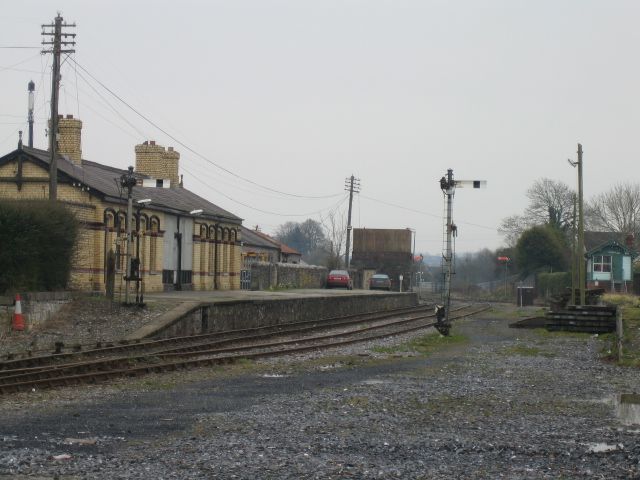
Navan Station now (above) and over half a century ago (below) Photo above: © Navan & District Historical Society
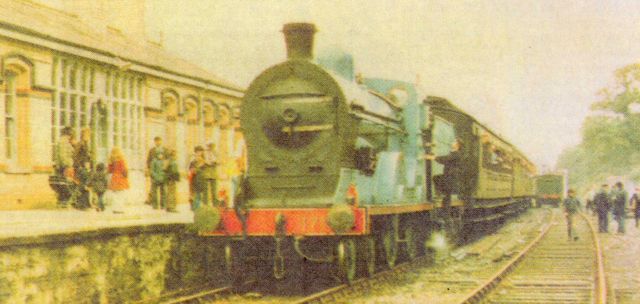
In 1850 the Drogheda to Navan line was opened.
In the previous year, during construction, a souterrain was found in the bank cutting at Dillonsland / Academy Street, on the Dublin side of the railway embankment. William Wilde in 1850 recorded the discovery of a souterrain when making the railway cutting. It was T-shaped, ending in beehive chambers.
The line was extended to Kells in 1853 and to Oldcastle in 1863. But to go through Drogheda from Dublin was the long way round and so a direct Dublin – Navan route was proposed.
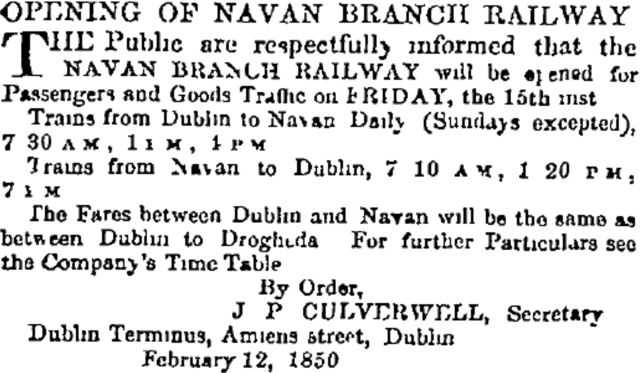
(above ) From the Freeman's Journal 13th Feb. 1850
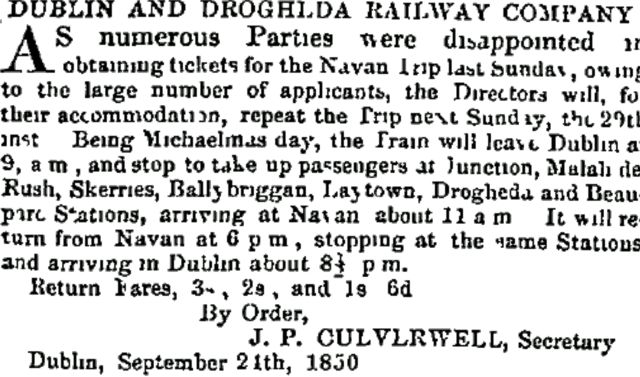
(above) From the Freeman's Journal, 24 Sept 1850
The Dublin and Meath Railway was incorporated in 1858 to make a line from Dublin to Athboy and Navan. The contractors, the Moore brothers, started work between Athboy and Trim. They had to abandon work one year later in October 1859 because the landowners were demanding too high a price for the route. They then concentrated on the Navan line.
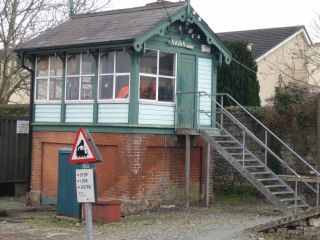
Junction Box Navan Station (above) Photo©N&DHS
The Navan line was completed and opened on 29th August, 1862. The Dublin and Meath railway had running power over the Dublin and Drogheda line from Navan to Kells. The Midland and Great Western Railway took a lease on the Dublin and Meath Railway in 1869 and eventually bought it out in 1888.
The line to Kingscourt was opened on 1st November, 1875. The Meath line from Dublin to Navan to Kingscourt was fifty miles in length. It was proposed to extend the line to join the Great Northern Railway but the plan was never put into being.
In the early twentieth century, the Great Northern Railway published an official guide which featured the Meath railways. They published this in a booklet called ‘Snapshots of the Valley of the Boyne, Lough Ramor and Royal Meath’. The railway and the river Boyne and the sights and buildings are described. Navan is described as a straggling and uninteresting town. There is a famous Irish tweed manufactory on the edge of the river, which is spanned by a fine railway viaduct.
Navan Junction - where the Cash & Carry is on the Carriage Rd.
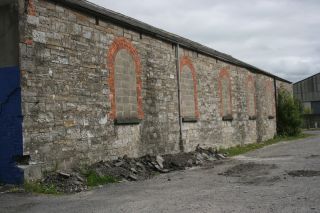

(above left) Old Railway Station near Carriage Rd and (right) the line of that railway today.
It had four platforms, a station master, four porters and two signalmen in 1912. In 1924 a special platform was erected at Proudstown Park to cater for the race goers.
A gypsum siding was put in at Kingscourt in 1939.
The Midland and Western Railway was absorbed by the Great Southern Railways in 1925 and that in turn was taken over by Coras Iompar Eireann in 1945. After World War II the use of the railways declined and they gradually closed down. The Dublin to Navan line was closed as a passenger service. The track from Dublin to Navan was removed from 30 March, 1963 onwards. The line from Navan to Kells and Oldcastle was closed on 30 Aprl, 1963.
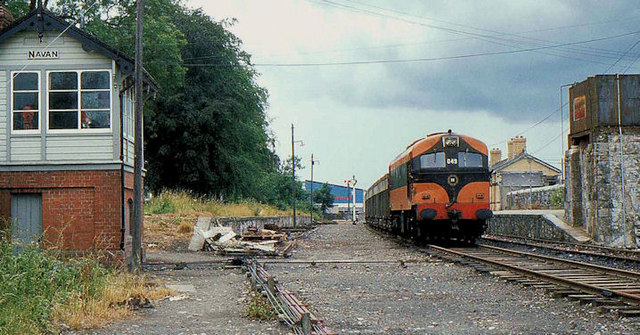
(above) Tara Mines train at Navan - carrying lead and zinc concentrate
A half mile of the Kells track was relaid for Tara Mines to ship lead and zinc concentrates through Dublin and Drogheda to smelters abroad. Gypsum from Kingscourt was transported to the cement factories in Limerick and Drogheda. Currently there is a proposal to reopen the line from Navan to Dublin.
*
Railways
The London Times, 4th May 1836 ~ Dublin, Drogheda and Navan, Ireland, Railway
In an advertisement the patrons and committee included:
The most Noble the Marquis of Conyngham
The most Noble the Marquis of Headfort
The Right Hon. Lord Killeen., Killeen-Castle
Charles Barnwall, Esq., Meadstown
Nicholas Codington, Esq., Old Bridge
Mathew Corbally, Esq., Corbalton-Hall
Leonard Cornwall, Esq., Brownstown
Sir Charles Dillon, Bart., Lismullin-House
William Dillon, Esq., Kilcarn
Thomas Gerrard, Esq., Liscarton-Castle
Gustavus Lambert, Esq., Beauparc
Henry Meredyth, Esq., Randelstown, High Sherriff of the County of Meath.
Francis Murphy, Esq., Kilcarn
James Lennox Naper, Esq., Loughcrew-house
Thomas Pepper, Esq., Ballygarth-castle
Henry Smith, Esq., Annesbrook
Sir Wm. M. Somerville, Bart, Somerville House
The Hon. Sir Francis Stanhope, Parsonstown
*
Navan Drogheda Railway
The Times (The London Times) 23 Feb 1841 ~ Court of Exchequer Guildhall Feb 22nd
Sittings at Nisi Prius before Lord Abinger and a special jury.
Bastrick v Lambert.
Sir F Pollock and Mr. Skinner were counsel for the plaintiff and Mr. Kelly with Mr. Smith appeared for the defendant.
The plaintiff is the well known civil engineer, and this action was brought to recover the sum of £337, balance of a claim for £363 from the defendant, under the following circumstances:-
In the year 1836 when the railroad mania was at its height both in England and Ireland, a project was started for a coastwise line to Drogheda to Dublin. A the same time a solicitor named Pentland, got up an opposition inland line to be called the Dublin, Drogheda and Navan Ireland Railroad, which was described in a most flourishing prospectus, as being a line supported by all landed proprietors along its course, many of whom were put down therein without their consent as patrons, provisional committee men, and London committee. Among the two latter classes, however, the defendant, who as a gentleman of property, residing at Beauparc county of Meath, consented to appear, he having a very kindly feeling towards the undertaking in question; and furthermore, he attended before the Parliamentary committee when the two rival lines were canvassed and their respective merits gone into.
In this state of things the plaintiff was applied to by Mr. Pentland, who was solicitor to the inland line, to lend his professional skill and weight thereto, and a retaining fee of 25 guineas was accordingly paid to him, 15 shillings of which was advanced by Mr. Baker, the Parliamentary agent, to Mr. Pentland. After this the plaintiff gave several attendances, and rendered other assistance to the bill, until it was abandoned, it being understood that £5,000 or more had been paid to Mr. Pentland by the coast line projectors to get rid of their rival. From that time to the commencement of this action the plaintiff has been unable to procure the satisfaction of his demands, and the work done having been proved as well as the retainer, it was now sought to fix Mr. Lambert with the liability for the sum above mentioned.
The jury found for the plaintiff to the full extent if his claim, namely for £337.
The Tablet 7 Nov 1846 Presentments
The baronies now proclaimed are 236 in number. At Fermoy, 46,846/. was granted, 600/. for building a Catholic chapel, the materials being already provided... At Navan 45,000/. was granted chiefly for embankments for a railroad...
These presentments were probably famine relief works. The embankments were for the Navan to Drogheda line which still exists. The amount was £45,000.
The Tablet 2 Feb 1850 The Navan Branch Line
The Railway Commissioners having already certified this line as ready for public traffic, will, in a few days, give a final certificate, such as the act requires, to authorise its transference to the Dublin and Drogheda Company, and it is expected that in the course of next week the line will be opened to the public. We are happy to say that both boards are proceeding amicably to arrange for the opening as speedily as possible.— Irish Railway Gazette.
The Tablet 23rd Feb 1850 ~ DUBLIN AND DROGHEDA RAILWAY –OPENING OF THE EXTENSION TO NAVAN.
The Navan branch of the Dublin and Drogheda Railway was opened on Friday, 15th inst., for public traffic. There are seventeen and a-half miles of the line now complete, as it is intended to extend to Kells, ten miles further, which can be completed, it is calculated, for about 4,000 pounds per mile. The principal feature of interest connected with the line is, the magnificent bridge spanning the River Boyne near its confluence with the Blackwater. It is of seven arches, each of fifty feet span, built of rough hewn limestone in the most permanent manner, and presents a noble feature in the landscape of the place.
Navan to Kilmessan Railway
Irish Times, 26 Oct 1859 Source: Meath People. Dublin and Meath Railway
The works on this line are being pressed forward with surpassing activity. With the exception of a few hundred yards, every inch between Navan and Kilmessan is ready for the laying down of the rails. The arches that are to span the viaduct over the Boyne are being turned, all the centres being raised; and the bridges at Assye and Grange are open for public traffic. Evidently the company are in earnest about their business, and they meet most efficient co-operators in the Messrs. Moore. - Meath People. (No copies of this newspaper survive).
The Times - The London Times 20 July 1861 Dublin to Navan Railway
The works on this line are progressing rapidly. About 11 miles in length on the permanent way have been laid from Navan to Knockmark and a further distance of eight miles the earthworks have been brought to formation level, ready for laying the rails. It is proposed to open the main line from its junction with the Midland Great Western Railway at Clonsilla to Navan early in the spring of 1862, a distance of 23 miles. The works on the company’s branch to Athboy, 12 miles in length, are also progressing favourably.
The Times 28 June 1867 Navan and Kingscourt Bill passed with special amendments.
The Times 16 Feb 1865 Railway Bills. Navan and Kingscourt. For a railway between these points and working arrangements:
Capital £120,000
Loan. £40,000
The Times 9 March 1871
The line from Navan to Kingscourt was now far advanced, and the directors had arranged with the company for a working agreement by mileage rate. The capital account showed that £3,339,009 had been expended leaving a balance against the company of £9,018.
The Times 14 Oct 1878 Railway Accident
An express passenger train from Dublin, ran into a cattle train at Navan station on Friday night smashing some of the buffers and knocking some of the cattle wagons off the rails. The guard of the express and one of the passengers received violent shocks, and the permanent way was blocked for two hours.
The Times 22 Nov 1887
A meeting of the shareholders, debenture holders and creditors of the Navan and Kingscourt Railway sanctioned yesterday, by an overwhelming majority the sale of the line to the Midland Great Western Railway Company of Ireland for £50,000.
The Times 4 Oct 1898 Railway-Drunken Persons
This afternoon the city coroner held an inquest on the body of a woman named Mary Ryan, aged 30, who died in the union hospital last Friday. Deceased and her husband when travelling from Navan to Dublin on September 10 were found by the ticket collector to be under the influence of drink, and he placed them in a carriage with four or five others also intoxicated. During the journey a disturbance arose, and the woman was bitten in the forefinger of her right hand by one of the men in the carriage with her. Medical evidence proved that her death was due to congestion of the lungs and heart failure arising from tetanus, due to the finger bite. The jury found a verdict in accordance with this testimony, and added an expression of opinion condemning the practice of railway companies in permitting drunken persons to travel in their carriages.
The Times 2 March 1909 ~ House of Lords (Before Lord Chancellor, Lord Macnaughten, Lord Atkinson and Lord Collins).
Cooke (Pauper) by his next friend v Midland Great Western Railway of Ireland Company.
Negligence- Liability of Railway Company.
This was an appeal from an order, dated June 14, 1907, of the Court of Appeal in Ireland which affirmed that of the Kings Bench Division dated February 28 1907 setting aside the findings verdict and judgment of a special jury and the Lord Chief Justice of Ireland, date June 21, 1906.
There was a gap through which children could get access to a turntable for turning engines around. On the 18th June 1905 Cooke aged 4 years two months and another boy 9 1/2 years old played at the turntable. Cooke's leg was injured and had to be amputated. The jury awarded £550 damages. The Court of Appeal and Kings Bench Division reversed this decision of the jury. It was appealed to the House of Lords who allowed the decision of the jury to stand.
No mention was made of Navan until Lord MacNaughten gave his opinion. In the course of his speech he said “The turntable seems to have been devoted or abandoned to the sustenance of the railway inspector’s goat and the diversion of the youth of Navan.”
The witnesses for Cooke were Tully, the herd and Gertrude Cooke his sister. Mr. Barnes C.E. gave evidence for the Railway. Fowler, a ganger for the railway gave unsatisfactory evidence.
Proper costs were allowed.”
This piece of case law is still in force in the UK and Ireland in 2014. The platforms for the Dublin to Navan Railway via Kilmessan were where the gym on the Carriage Road is now. On the Trim Road where the turn for Beaufort College and Enterprise Centre is today was the line of the railway. It went under the road here. The turntable for turning engines around was where Nolans premises is now. It is clearly shown on maps from the 1800's. This is the route of the proposed Dunboyne to Navan railway extension.
The Times 18 Aug 1919 ~ Goods Train Derailed in Meath
An outrage of a kind that is rare in Ireland was committed on Friday night, when a portion of the Great Northern Railway between Beauparc and Navan, in the county of Meath, was torn up, and a goods train was derailed, and almost wholly destroyed. It is generally believed in the neighbourhood that the outrage is connected with the strike of farm workers in the county. A hut used by railway surface men was broken open during the night, and, tools were removed with which a rail was torn up and flung into a field near the line. Fortunately the first train that passed was a goods train, otherwise the loss of life might have been heavy. The train consisted of 57 wagons which were being taken from Drogheda to Navan. When it reached the spot where the rail had been removed, the driver applied his brakes, and the engine bumped over the sleepers and took the rails again. The wagons, however, became detached, and were piled up in a great heap. Sixteen of these at the back kept the rails, but the remaining 41 were damaged, 30 being completely wrecked.
The line was blocked, and cannot be cleared before Tuesday. The rail which was removed was 15 feet long, and it is believed that at least 10 men must have taken part in the outrage.
On Saturday morning a railwayman in the town of Navan found the following notice written in red ink in the letter box of his house:
'Beware- Northern line torn up two miles from Navan. Tell Station Master, before nine.'
The man took the message to the Station Master, who, however had already been informed of the derailing of the train. The driver and fireman escaped injury, but the guard Patrick Howard, was cut about the forehead. The police visited the scene of the outrage during the day, but no arrests have been made,
Patrick Loughran, Navan Company, Irish Volunteers, in a statement to the Bureau of Military History tells the story. The full statement is at Navan Coy., Irish Volunteers.
Around this time there was a strike of farm workers on the big estates in the county. On the instructions of the Brigade 0/C., Sean Boylan, a goods train was derailed at Farganstown, Navan, by members of Navan Company in charge of Lieut. C. McMahon. This action was taken following representation by strike leaders to the Brigade Staff. During the general parliamentary election in December 1918, all our members again took a leading part, canvassing, supplying personation agents and tallymen.
Other activities by the Navan Company at the latter end of the year included the organisation and formation of Volunteer companies at Bohermeen, Johnstown, Stackallen, Castletown and other areas. I was sworn in a member of the I.R.B. at this time. The year 1919 saw the formation of the various companies in Co. Meath into battalion areas. Navan became the H.Q. of the 6th Battalion which comprised companies in Navan, Stackallen, Johnstown, Bohermeen and Castletown.
A short time later, when companies were formed in Clongill, Kilbarry and Yellow Furze, they were incorporated into the battalion. I became Battalion 0/C., A. Levins vice-0/C., Kieran O'Connell adjutant, and Joe Hughes engineer.
Company training in the area was now intensified. Rifles and revolvers were purchased secretly from members of British armed forces. At the end of the year, shotguns and other arms were collected from civilians, resulting in the securing of a goodly store of weapons, chiefly shotguns. In some cases we raided the homes of loyalists and seized the guns. In a couple of these raids we were attacked by the owners with shotguns. Another Volunteer and myself received a number of pellets in the legs. The arms obtained in the raids were dumped in a house in Curraghtown.
In November, the police barracks at Lismullen or Dillon's Bridge as it is often called four miles from Navan, was attacked by selected members of the Navan Battalion. The attacking party numbered 20. A ruse to gain admission to the barracks failed, after which the attack opened and lasted about 45 minutes. Unfortunately, the arms were not good enough; they were mostly shotguns and a few .22 rifles, so the capture of the barracks was not effected. A police sergeant was wounded in the attack. A considerable amount of preparation was made previously, including instruction in the use of bombs, scouting and reconnoitring the position. The Navan company took part in preparing for similar attacks on R.I.C. barracks in George's Cross and Bohermeen, but before the attacks matured, they were vacated by the R.I.C.
*
See also: Railway Street